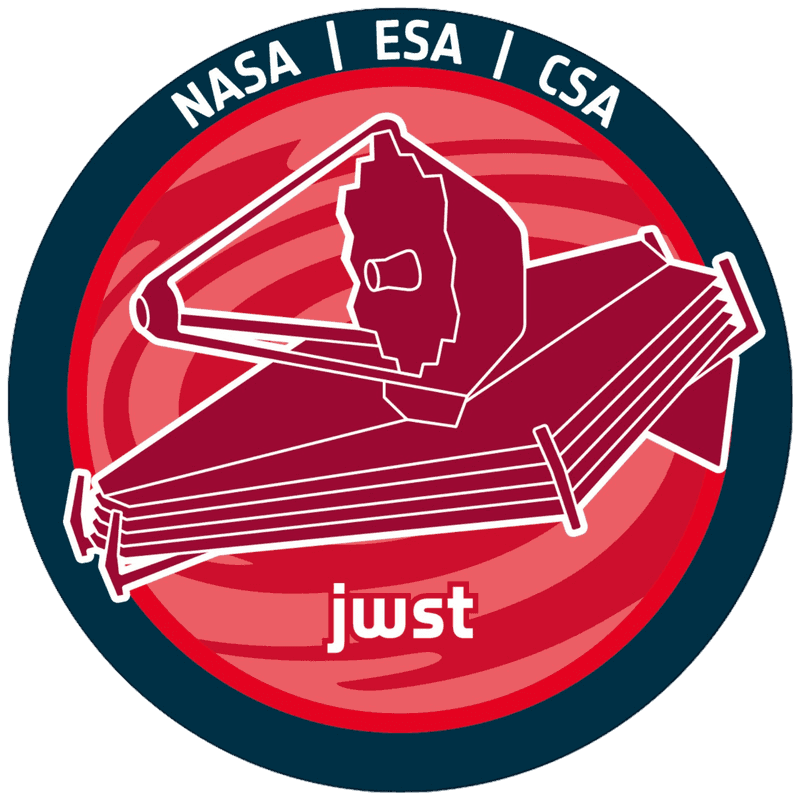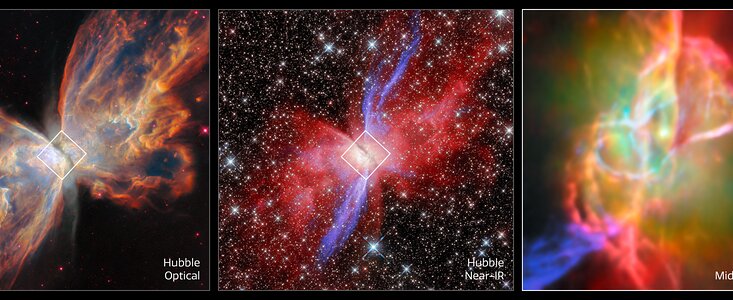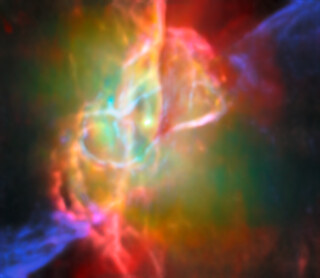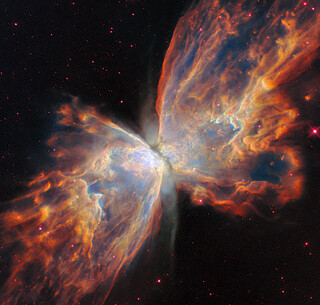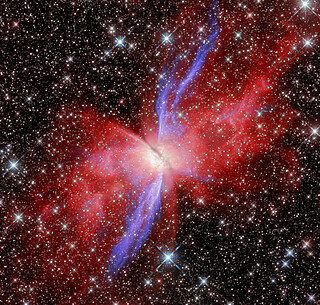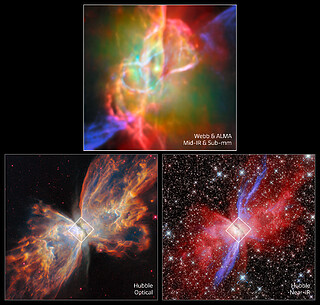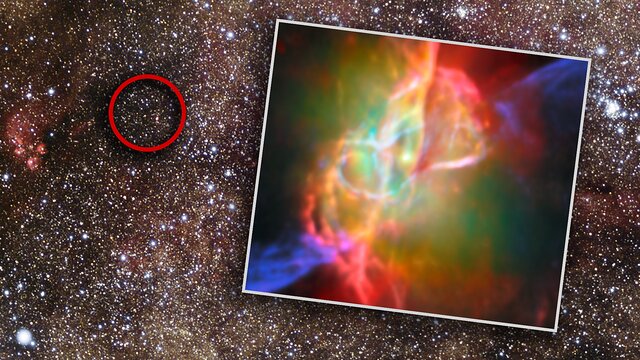weic2517 — Photo Release
Webb investigates complex heart of a cosmic butterfly
27 August 2025
The NASA/ESA/CSA James Webb Space Telescope has revealed new details in the core of the Butterfly Nebula, NGC 6302. From the dense, dusty torus that surrounds the star hidden at the centre of the nebula to its outflowing jets, the Webb observations reveal many new discoveries that paint a never-before-seen portrait of a dynamic and structured planetary nebula.
The Butterfly Nebula, located about 3400 light-years away in the constellation Scorpius, is one of the best-studied planetary nebulae in our galaxy. This stunning nebula was previously imaged by the NASA/ESA Hubble Space Telescope. Now, Webb has captured a new view of this nebula.
Planetary nebulae are among the most beautiful and most elusive creatures in the cosmic zoo. These nebulae form when stars with masses between about 0.8 and 8 times the mass of the Sun shed most of their mass at the end of their lives. The planetary nebula phase is fleeting, lasting only about 20 000 years.
Contrary to the name, planetary nebulae have nothing to do with planets: the naming confusion began several hundred years ago, when astronomers reported that these nebulae appeared round, like planets. The name stuck, even though many planetary nebulae aren’t round at all - and the Butterfly Nebula is a prime example of the fantastic shapes that these nebulae can take.
The Butterfly Nebula is a bipolar nebula, meaning that it has two lobes that spread in opposite directions, forming the ‘wings’ of the butterfly. A dark band of dusty gas poses as the butterfly’s ‘body’. This band is actually a doughnut-shaped torus that’s being viewed from the side, hiding the nebula’s central star - the ancient core of a Sun-like star that energises the nebula and causes it to glow. The dusty doughnut may be responsible for the nebula’s insectoid shape by preventing gas from flowing outward from the star equally in all directions.
This new Webb image zooms in on the centre of the Butterfly Nebula and its dusty torus, providing an unprecedented view of its complex structure. The image uses data from Webb’s Mid-InfraRed Instrument (MIRI) working in integral field unit mode. This mode combines a camera and a spectrograph to take images at many different wavelengths simultaneously, revealing how an object’s appearance changes with wavelength. The research team supplemented the Webb observations with data from the Atacama Large Millimetre/submillimetre Array, a powerful network of radio dishes.
Researchers analysing these Webb data identified nearly 200 spectral lines, each of which holds information about the atoms and molecules in the nebula. These lines reveal nested and interconnected structures traced by different chemical species.
The research team has pinpointed the location of the Butterfly Nebula’s central star, which heats a previously undetected dust cloud around it, making the latter shine brightly at the mid-infrared wavelengths that MIRI is sensitive to. The location of the nebula’s central star has remained elusive until now, because this enshrouding dust renders it invisible at optical wavelengths. Previous searches for the star lacked the combination of infrared sensitivity and resolution necessary to spot its obscuring warm dust cloud. With a temperature of 220 000 Kelvin, this is one of the hottest known central stars in a planetary nebula in our galaxy.
This blazing stellar engine is responsible for the nebula’s gorgeous glow, but its full power may be channelled by the dense band of dusty gas that surrounds it: the torus. The new Webb data show that the torus is composed of crystalline silicates like quartz as well as irregularly shaped dust grains. The dust grains have sizes on the order of a millionth of a metre - large, as far as cosmic dust is considered - indicating that they have been growing for a long time.
Outside the torus, the emission from different atoms and molecules takes on a multilayered structure. The ions that require the largest amount of energy to form are concentrated close to the centre, while those that require less energy are found farther from the central star. Iron and nickel are particularly interesting, tracing a pair of jets that blast outward from the star in opposite directions.
Intriguingly, the team also spotted light emitted by carbon-based molecules known as polycyclic aromatic hydrocarbons, or PAHs. They form flat, ring-like structures, much like the honeycomb shapes found in beehives. On Earth, we often find PAHs in smoke from campfires, car exhaust, or burnt toast. Given the location of the PAHs, the research team suspects that these molecules form when a ‘bubble’ of wind from the central star bursts into the gas that surrounds it. This may be the first-ever evidence of PAHs forming in a oxygen-rich planetary nebula, providing an important glimpse into the details of how these molecules form.
The results have been published today in the Monthly Notices of the Royal Astronomical Society.
More information
Webb is the largest, most powerful telescope ever launched into space. Under an international collaboration agreement, ESA provided the telescope’s launch service, using the Ariane 5 launch vehicle. Working with partners, ESA was responsible for the development and qualification of Ariane 5 adaptations for the Webb mission and for the procurement of the launch service by Arianespace. ESA also provided the workhorse spectrograph NIRSpec and 50% of the mid-infrared instrument MIRI, which was designed and built by a consortium of nationally funded European Institutes (The MIRI European Consortium) in partnership with JPL and the University of Arizona.
Webb is an international partnership between NASA, ESA and the Canadian Space Agency (CSA).
Links
Contacts
Bethany Downer
ESA/Webb Chief Science Communications Officer
Email: [email protected]
ESA Newsroom and Media Relations Office
Email: [email protected]
About the Release
| Release No.: | weic2517 | |
|---|---|---|
